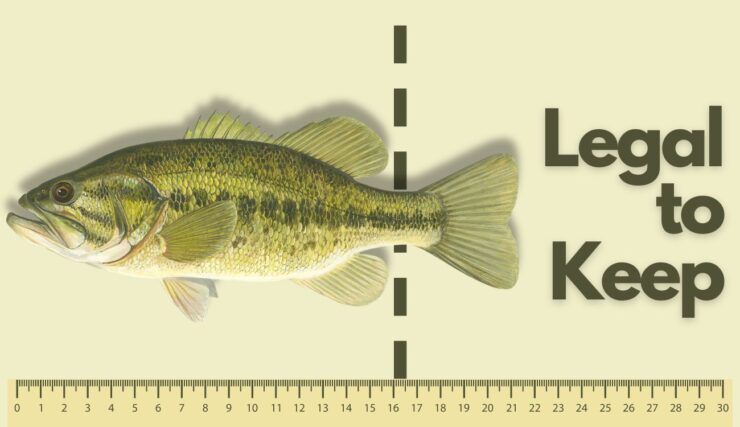Welcome to the world of largemouth bass, a species that has captured the hearts of our anglers and nature enthusiasts alike. Largemouth bass, scientifically known as Micropterus salmoides, is a species of black bass and one of the most popular game fish in North America.
While these are renowned for their fighting spirit and the thrill they provide when hooked, their culinary potential is often overlooked. We’ll explore this topic in-depth, providing a comprehensive guide to the edibility, nutritional value, and preparation of largemouth bass.
Table of Contents
ToggleCharacteristics
Largemouth bass are easily identifiable by their robust body, greenish to brownish coloration, and distinctive horizontal stripe along their flank. Their lower jaw extends beyond the back edge of the eye, giving them their “largemouth” moniker. They can grow quite large, with the world record standing at a whopping 22 pounds 4 ounces.
The habitat of the largemouth bass is diverse, ranging from clear, vegetated lakes to muddy ponds and slow-moving rivers. They prefer warmer waters and are most active in temperatures between 65 and 85 degrees Fahrenheit.
Largemouth bass are ambush predators, using cover like vegetation, logs, or man-made structures to hide and surprise their prey.
Distribution-wise, largemouth bass are native to North America, spanning from the Great Lakes down to Mexico. However, due to their popularity as sport fish, they have been introduced to many other parts of the world, including Europe, Asia, and South Africa.
This widespread distribution and adaptability make them a common catch for anglers worldwide.
What About Its Edibility?

So, can you eat largemouth bass? The simple answer is yes. They are not only safe to eat, but they can also be quite delicious if prepared correctly. However, like with any wild-caught fish, there are several factors to consider when deciding whether to consume them.
Firstly, the quality of the water where the bass was caught can significantly affect its taste and safety. Fish from clean, clear waters are generally safer and tastier than those from polluted or stagnant waters.
Secondly, the size of the bass can also influence its credibility. Smaller bass, typically under 3 pounds, tend to have a more delicate flavor and a less tough texture than larger ones.
Lastly, local regulations and advisories should be taken into account. Some areas may have restrictions on consuming bass due to high levels of contaminants like mercury or PCBs. Always check with local wildlife agencies or health departments before consuming fish from unfamiliar waters.
Nutritional Value
These fish are not just a fun catch; they also offer a wealth of nutritional benefits. They are a good source of lean protein, which is essential for muscle growth and repair. A 3-ounce serving of cooked bass provides around 20 grams of protein, which is about 40% of the recommended daily intake.
In addition to protein, they are rich in essential vitamins and minerals. They are a good source of Vitamin D, which is crucial for bone health, and Vitamin B12, which supports nerve function. These also contain significant amounts of phosphorus and selenium, both of which play vital roles in numerous bodily functions.
Moreover, largemouth bass are a source of omega-3 fatty acids, which are known for their heart health benefits. While they don’t contain as much omega-3 as fatty fish like salmon or mackerel, they still provide a decent amount, especially when compared to other freshwater species.
Regulations and Guidelines

Fishing for largemouth bass is subject to regulations and guidelines designed to maintain healthy fish populations and ecosystems. These rules vary by location and may include size and bag limits, seasonal closures, and gear restrictions. It’s essential to familiarize yourself with these regulations before heading out to fish.
In many areas, catch and release is encouraged, especially for these species. This practice helps to preserve the breeding population and ensure future generations of anglers can enjoy the thrill of catching these magnificent fish.
However, keeping smaller bass for consumption can actually benefit the overall population by reducing competition for resources.
Remember, fishing regulations are not just suggestions; they are legally enforceable rules. Violating these regulations can result in hefty fines or even loss of fishing privileges. Always check with the local wildlife agency or fishing authority for the most accurate and up-to-date information.
Preparing Largemouth Bass for Consumption
Once you’ve caught the fish and decided to keep it for consumption, the next step is preparing it. The first task is to clean and fillet the fish. This process involves removing the scales, gutting the fish, and cutting the meat into fillets. It’s important to do this as soon as possible after catching the fish to maintain the freshness and quality of the meat.
When it comes to cooking, there are numerous techniques you can use. Grilling, baking, and frying are all popular methods. The key is to use a recipe that complements the mild flavor of the bass without overpowering it.
Simple seasonings like lemon, garlic, and fresh herbs can enhance the taste of the fish without masking its natural flavor.
Like all fish, largemouth bass should be cooked to an internal temperature of 145 degrees Fahrenheit to ensure it’s safe to eat. Use a food thermometer to check the temperature at the thickest part of the fillet.
Culinary Uses

Largemouth bass are versatile in the kitchen, lending themselves to a variety of recipes and cooking methods. Their firm, white meat holds up well to grilling and frying, making them a popular choice for fish tacos, sandwiches, and stir-fries. They can also be baked or broiled with a simple seasoning of herbs and spices for a healthier option.
In the Southern United States, they are often the star of traditional fish fries, where they are coated in a crispy batter and deep-fried to golden perfection. In Asian cuisine, they might be steamed with ginger and scallions, then drizzled with a hot oil soy sauce for a flavorful and aromatic dish.
Despite their versatility, it’s important to remember that this fish has a relatively mild flavor.
They are best paired with light sauces and seasonings that enhance rather than overpower their natural taste. Overcooking can also result in a dry, tough texture, so be sure to monitor the cooking time closely.
Flavor and Texture
Largemouth bass has a mild, slightly sweet flavor that is less fishy than some other freshwater species. Their meat is white, firm, and flaky, with a texture similar to that of grouper or halibut.
The taste and texture can vary depending on the diet and habitat of the bass, with fish from clear, vegetated waters generally having a better flavor than those from muddy or stagnant waters.
Compared to other commonly consumed fish species, largemouth bass are less oily than salmon or mackerel, resulting in a lighter, less rich flavor. They are also less flaky and delicate than fish like cod or haddock, making them more suitable for recipes that require a firmer texture.
However, it’s worth noting that the taste of largemouth bass can be a matter of personal preference. Some people enjoy their unique flavor and texture, while others prefer the taste of other fish species. The best way to determine if you like this fish is to try it for yourself!
Potential Health Concerns

While the above-mentioned fish is generally safe to eat, there are potential health concerns to be aware of. Like all fish, they can accumulate contaminants from the water they live in. The most common of these are mercury and PCBs, both of which can have harmful effects on human health if consumed in large amounts.
The level of contaminants in largemouth bass can vary depending on the quality of the water they inhabit. Fish from polluted waters or areas with heavy industrial activity are more likely to have high levels of contaminants.
Pregnant women, nursing mothers, and young children are particularly vulnerable to these contaminants and should limit their consumption of largemouth bass from such areas. It’s important to check with local health departments or wildlife agencies for advisories on fish consumption.
These advisories provide information on the safety of eating fish from specific waters and can help you make informed decisions about whether to consume largemouth bass.
Sustainable Fishing Practices
Sustainable fishing practices are crucial for maintaining healthy populations of largemouth bass and preserving the ecosystems they inhabit. These practices include following fishing regulations, practicing catch and release, and using gear that minimizes harm to the fish and their habitat.
Responsible angling is not just about following the rules; it’s also about respecting the fish and the environment. This means handling caught fish carefully to minimize stress and injury, and releasing them quickly and gently back into the water.
It also means avoiding fishing in sensitive areas like spawning grounds or nursery habitats.
Conservation is a shared responsibility, and every angler can play a part in preserving our fisheries for future generations. By practicing sustainable fishing, we can continue to enjoy the thrill of catching these species and the pleasure of eating them, while also ensuring their survival and well-being.
Alternative Options
If you’re not a fan of this fish, or if you’re concerned about potential contaminants, there are plenty of other fish species that make excellent alternatives. Smallmouth bass, for example, are closely related and have a similar flavor and texture. They are also less likely to accumulate high levels of contaminants due to their preference for cooler, clearer waters.
Other freshwater species like walleye, crappie, and trout can also make great substitutes for largemouth bass. They are all delicious in their own right and can be prepared in similar ways. If you prefer saltwater fish, species like snapper, grouper, or flounder are good options.
The key to enjoying fish is to choose species that you like and that comes from clean, healthy waters. Always check local advisories and regulations before fishing or consuming fish.
Frequently Asked Questions (FAQ):
Are there any specific seasons or times of the year when this fish is best for consumption?
Largemouth bass can be consumed throughout the year, but the taste and texture may vary slightly depending on the season.
Can you eat it raw if it has been frozen?
It is generally recommended to cook it, even if it has been previously frozen, to ensure food safety.
How long does it take to cook the fish?
The cooking time for largemouth bass depends on the method used and the thickness of the filets but generally ranges from 8 to 12 minutes.
How should it be stored to maintain freshness?
It should be stored properly in a refrigerator at temperatures below 40°F (4°C) and consumed within a few days for optimal freshness.
Can you eat largemouth bass caught in polluted waters?
It is generally recommended to avoid consuming fish caught in heavily polluted waters due to potential health risks.
Conclusion
In conclusion, largemouth bass are not only an exciting catch for anglers, but they can also be a tasty and nutritious addition to your diet. They are safe to eat, provided they come from clean waters and are prepared and cooked properly.
However, it’s important to be aware of local regulations and advisories, as well as the potential health concerns associated with consuming wild-caught fish.
So the next time you hook a bass, why not consider taking it home for dinner? You might just discover a new favorite dish just like me!
Related Posts:
- Heavy Duty Fishing: 11 Best Rods And Reels For Big Fish 2024
- 16 Best Kayak For Beginners 2024 - Kayaking Adventure Gear
- 10 Best Saltwater Fishing Boats - Ultimate Angling Adventure
- 12 Best Fishing Lures Ever 2024 - Baits That…
- 12 Best Kayak GPS 2024 - Find Your Way to Adventure
- 12 Best Truck Bed Hitch Extenders for Kayak 2024 -…












